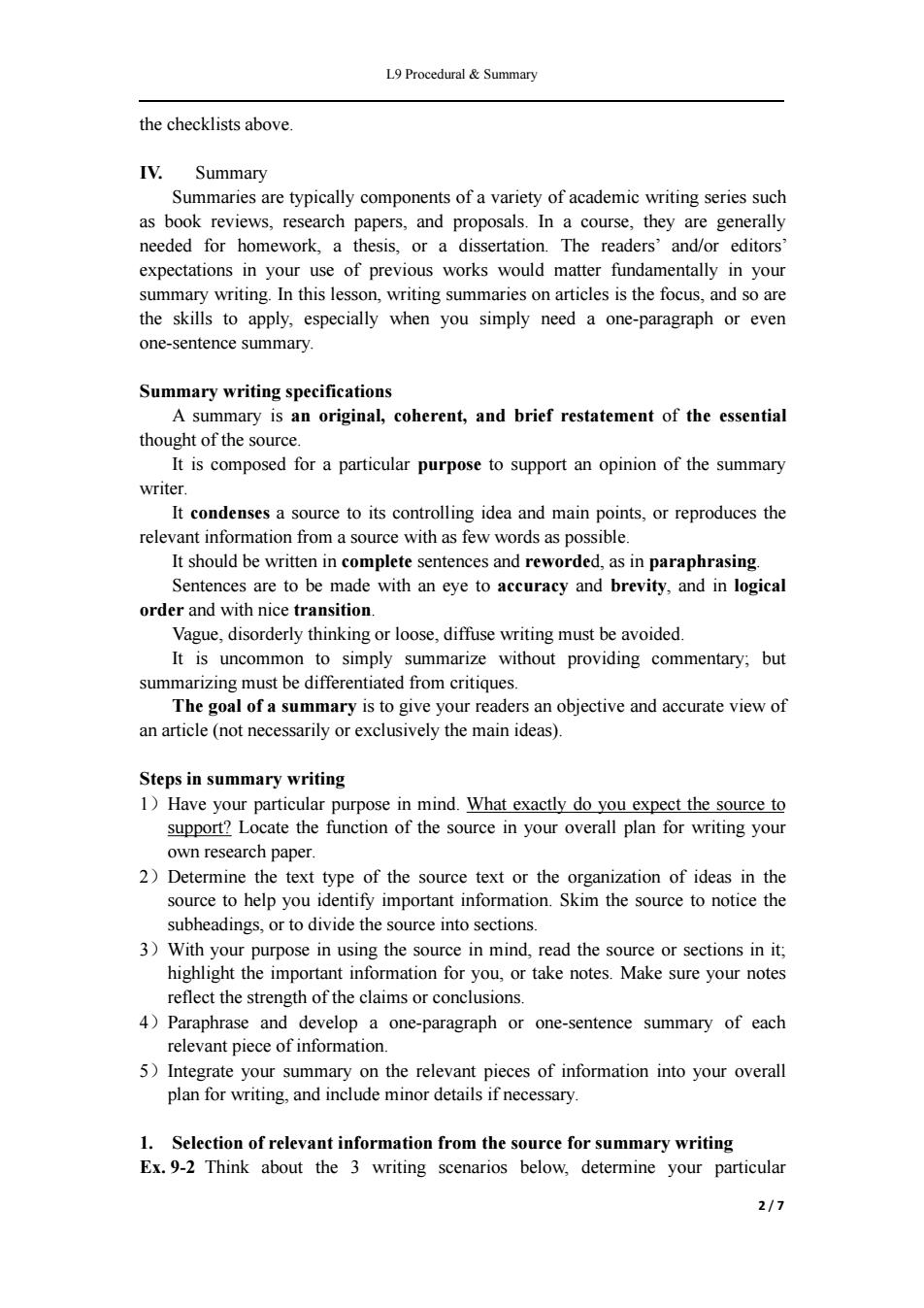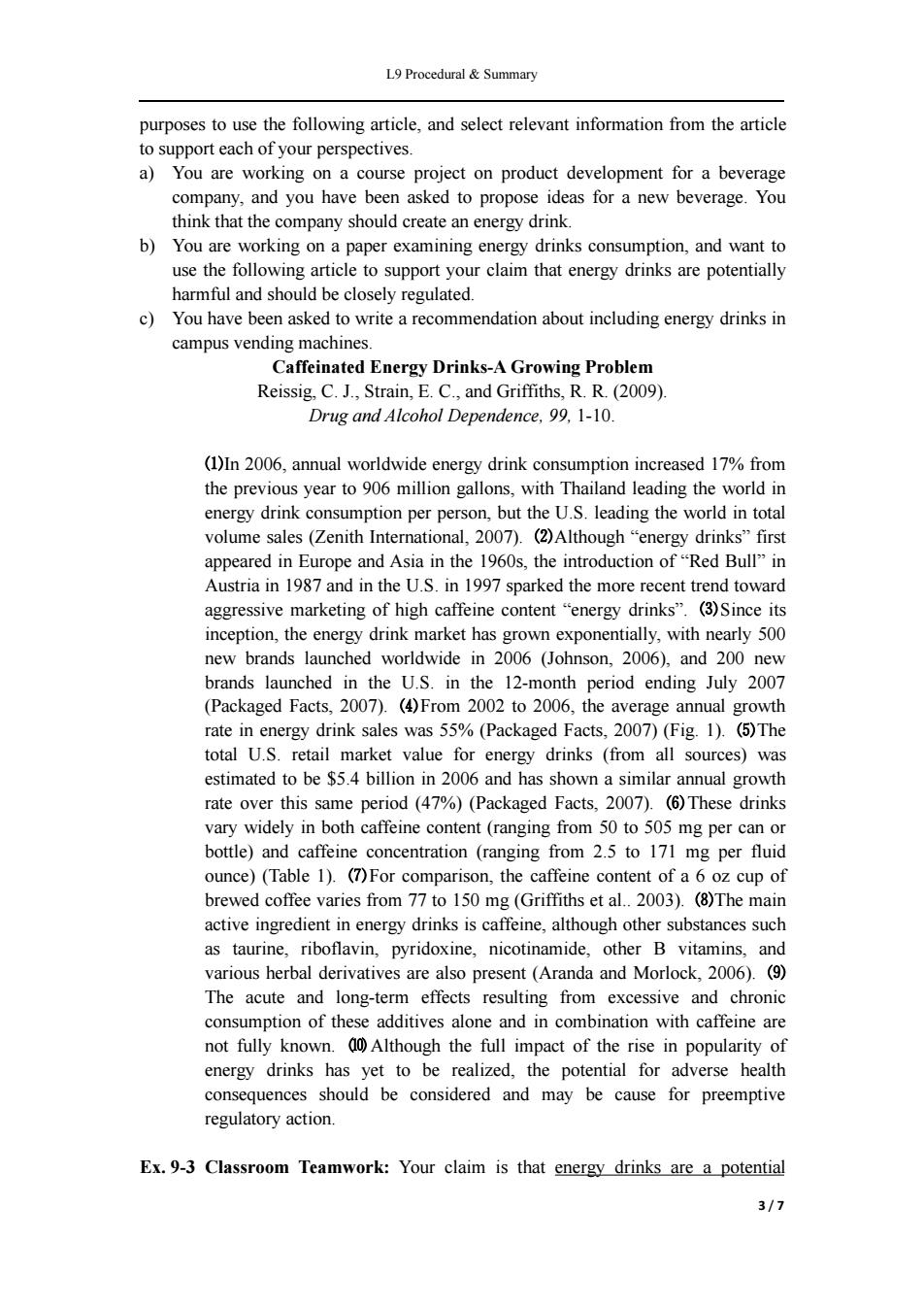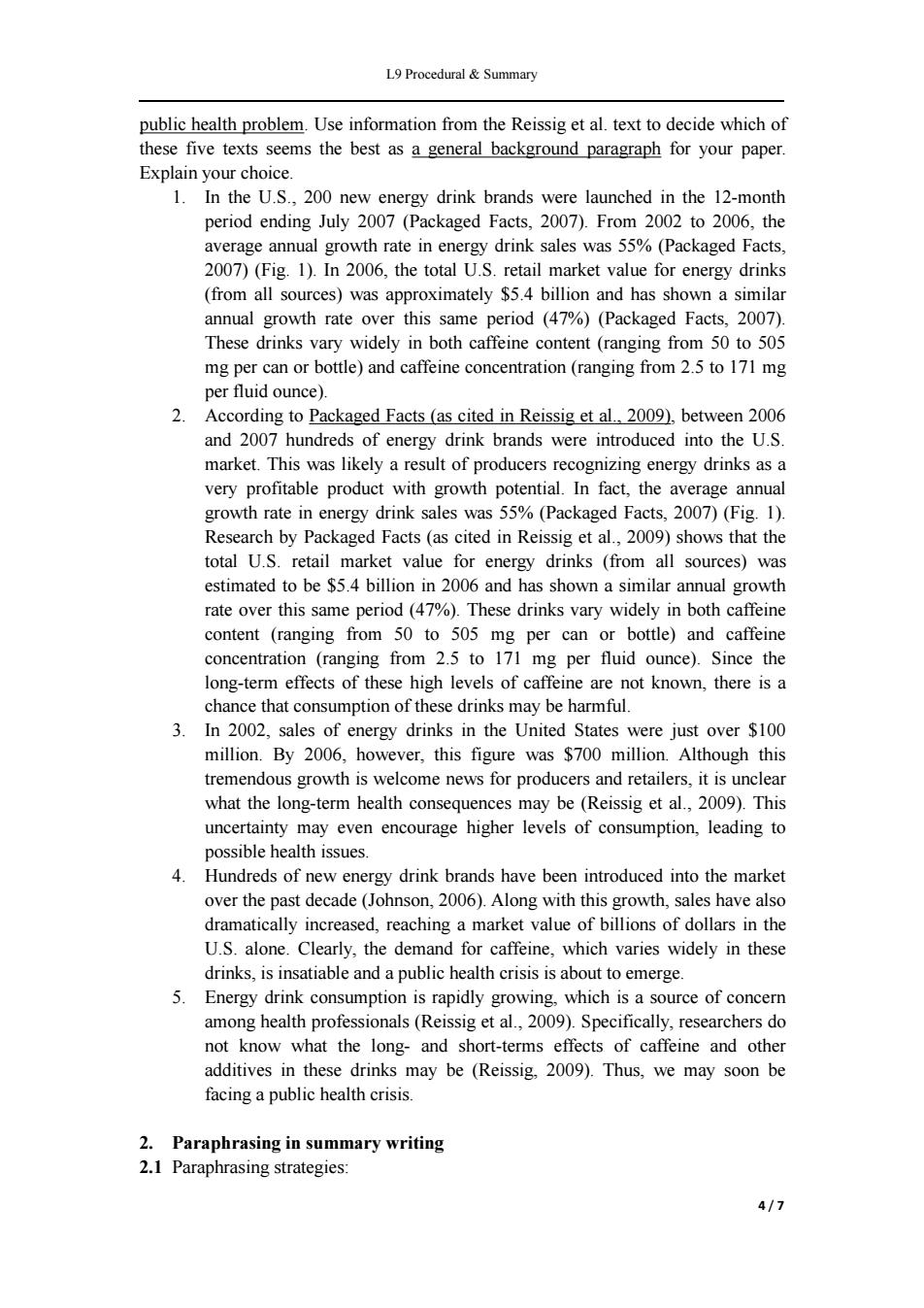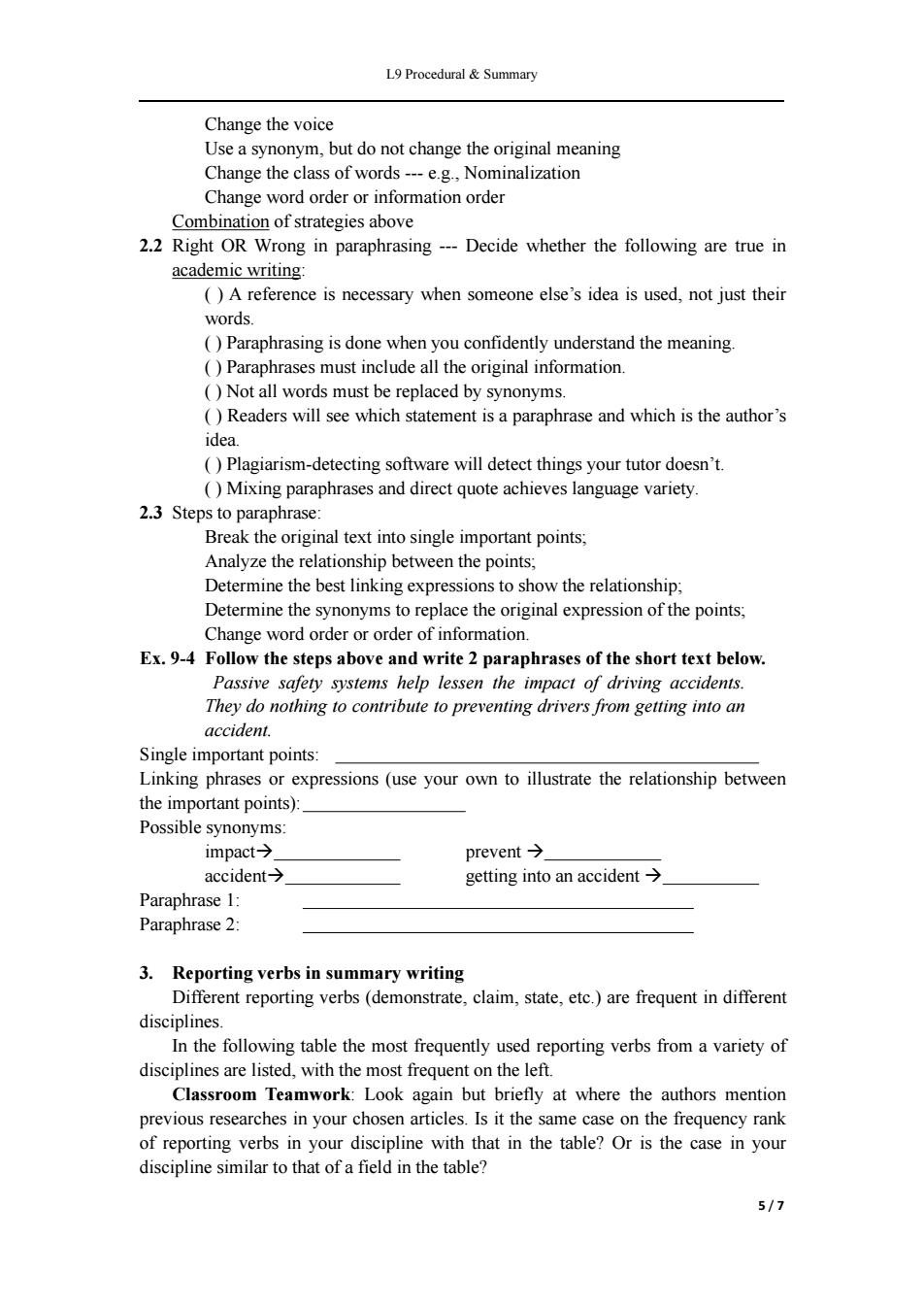
L9 Procedural Summary You are supposed to bring your own previous Methodology writing to L9 classroom. Preview the handout and search on the Internet to guarantee your adequacy in vocabulary,and to be well-prepared for classroom activities. Lesson 9 Reading and Writing Procedural and Summary I. Your Mini-talk Every class member must be ready with their individual mini-talk each week. II.The Text Types:Procedural 1.Procedure:instructing how to do an activity 2.Protocol:Rules,Warning,Laws 3.Procedural Recount:describing how an activity was done Do particular words in the Methodology in your chosen articles mark the sequence of steps in the researches?(Procedural indicators/Transitions) What verbs do the authors use to replace“use”/“apply”in cases of material,, and to replace"do"in describing steps in the researches? Is a single term repeated to refer to one particular material/method? III.Checklists in writing the Methodology 1.Writing ethics checklist ·Reproducibility Data manipulation(e.g.,filtering or smoothing) Documentation of inspiration 2.Language use checklist Abbreviations Define only once Stand for only one entity/concept Be grammatically solid space between values and units except forand ·The list of items=in parallel(with“,and'/“,or") ·Complete sentences(with“and'/“,or") “respectively” e.g.Data on...,...,and...were compiled by...,...,and... respectively. ·Vdash(-)×hyphen(-)for"the range of A-B”Numeric keypad ·Equations Professional format Numbering Undefined symbols defined Ex.9-1 Improve your neighbor's previous writing of the Methodology by referring to 1/7
L9 Procedural & Summary 1 / 7 You are supposed to bring your own previous Methodology writing to L9 classroom. Preview the handout and search on the Internet to guarantee your adequacy in vocabulary, and to be well-prepared for classroom activities. Lesson 9 Reading and Writing Procedural and Summary I. Your Mini-talk Every class member must be ready with their individual mini-talk each week. II. The Text Types: Procedural 1. Procedure: instructing how to do an activity 2. Protocol: Rules, Warning, Laws 3. Procedural Recount: describing how an activity was done • Do particular words in the Methodology in your chosen articles mark the sequence of steps in the researches? (Procedural indicators / Transitions) • What verbs do the authors use to replace “use” / “apply” in cases of material, and to replace “do” in describing steps in the researches? • Is a single term repeated to refer to one particular material/method? III. Checklists in writing the Methodology 1. Writing ethics checklist • Reproducibility • Data manipulation (e.g., filtering or smoothing) • Documentation of inspiration 2. Language use checklist • Abbreviations Define only once Stand for only one entity/concept Be grammatically solid • space between values and units except for “%” and “°” • The list of items = in parallel (with “, and” / “, or”) • Complete sentences (with “, and” / “, or”) • “respectively” e.g. Data on …, …, and … were compiled by …, …, and … respectively. • √ dash (–) × hyphen (-) for “the range of A–B” (Numeric keypad) • Equations Professional format Numbering Undefined symbols = defined Ex. 9-1 Improve your neighbor’s previous writing of the Methodology by referring to

L9 Procedural Summary the checklists above. IV.Summary Summaries are typically components of a variety of academic writing series such as book reviews,research papers,and proposals.In a course,they are generally needed for homework,a thesis,or a dissertation.The readers'and/or editors expectations in your use of previous works would matter fundamentally in your summary writing.In this lesson,writing summaries on articles is the focus,and so are the skills to apply,especially when you simply need a one-paragraph or even one-sentence summary. Summary writing specifications A summary is an original,coherent,and brief restatement of the essential thought of the source. It is composed for a particular purpose to support an opinion of the summary writer. It condenses a source to its controlling idea and main points,or reproduces the relevant information from a source with as few words as possible. It should be written in complete sentences and reworded,as in paraphrasing. Sentences are to be made with an eye to accuracy and brevity,and in logical order and with nice transition. Vague,disorderly thinking or loose,diffuse writing must be avoided. It is uncommon to simply summarize without providing commentary;but summarizing must be differentiated from critiques. The goal of a summary is to give your readers an objective and accurate view of an article(not necessarily or exclusively the main ideas). Steps in summary writing 1)Have your particular purpose in mind.What exactly do you expect the source to support?Locate the function of the source in your overall plan for writing your own research paper. 2)Determine the text type of the source text or the organization of ideas in the source to help you identify important information.Skim the source to notice the subheadings,or to divide the source into sections. 3)With your purpose in using the source in mind,read the source or sections in it; highlight the important information for you,or take notes.Make sure your notes reflect the strength of the claims or conclusions. 4)Paraphrase and develop a one-paragraph or one-sentence summary of each relevant piece of information. 5)Integrate your summary on the relevant pieces of information into your overall plan for writing,and include minor details if necessary. 1.Selection of relevant information from the source for summary writing Ex.9-2 Think about the 3 writing scenarios below,determine your particular 2/7
L9 Procedural & Summary 2 / 7 the checklists above. IV. Summary Summaries are typically components of a variety of academic writing series such as book reviews, research papers, and proposals. In a course, they are generally needed for homework, a thesis, or a dissertation. The readers’ and/or editors’ expectations in your use of previous works would matter fundamentally in your summary writing. In this lesson, writing summaries on articles is the focus, and so are the skills to apply, especially when you simply need a one-paragraph or even one-sentence summary. Summary writing specifications A summary is an original, coherent, and brief restatement of the essential thought of the source. It is composed for a particular purpose to support an opinion of the summary writer. It condenses a source to its controlling idea and main points, or reproduces the relevant information from a source with as few words as possible. It should be written in complete sentences and reworded, as in paraphrasing. Sentences are to be made with an eye to accuracy and brevity, and in logical order and with nice transition. Vague, disorderly thinking or loose, diffuse writing must be avoided. It is uncommon to simply summarize without providing commentary; but summarizing must be differentiated from critiques. The goal of a summary is to give your readers an objective and accurate view of an article (not necessarily or exclusively the main ideas). Steps in summary writing 1)Have your particular purpose in mind. What exactly do you expect the source to support? Locate the function of the source in your overall plan for writing your own research paper. 2)Determine the text type of the source text or the organization of ideas in the source to help you identify important information. Skim the source to notice the subheadings, or to divide the source into sections. 3)With your purpose in using the source in mind, read the source or sections in it; highlight the important information for you, or take notes. Make sure your notes reflect the strength of the claims or conclusions. 4)Paraphrase and develop a one-paragraph or one-sentence summary of each relevant piece of information. 5)Integrate your summary on the relevant pieces of information into your overall plan for writing, and include minor details if necessary. 1. Selection of relevant information from the source for summary writing Ex. 9-2 Think about the 3 writing scenarios below, determine your particular

L9 Procedural Summary purposes to use the following article,and select relevant information from the article to support each of your perspectives. a)You are working on a course project on product development for a beverage company,and you have been asked to propose ideas for a new beverage.You think that the company should create an energy drink. b)You are working on a paper examining energy drinks consumption,and want to use the following article to support your claim that energy drinks are potentially harmful and should be closely regulated. c)You have been asked to write a recommendation about including energy drinks in campus vending machines. Caffeinated Energy Drinks-A Growing Problem Reissig,C.J.,Strain,E.C.,and Griffiths,R.R.(2009) Drug and Alcohol Dependence,99,1-10. (1)In 2006,annual worldwide energy drink consumption increased 17%from the previous year to 906 million gallons,with Thailand leading the world in energy drink consumption per person,but the U.S.leading the world in total volume sales(Zenith International,2007).(2)Although"energy drinks"first appeared in Europe and Asia in the 1960s,the introduction of"Red Bull"in Austria in 1987 and in the U.S.in 1997 sparked the more recent trend toward aggressive marketing of high caffeine content "energy drinks".(3)Since its inception,the energy drink market has grown exponentially,with nearly 500 new brands launched worldwide in 2006 (Johnson,2006),and 200 new brands launched in the U.S.in the 12-month period ending July 2007 (Packaged Facts,2007).(4)From 2002 to 2006,the average annual growth rate in energy drink sales was 55%(Packaged Facts,2007)(Fig.1).(5)The total U.S.retail market value for energy drinks (from all sources)was estimated to be $5.4 billion in 2006 and has shown a similar annual growth rate over this same period(47%)(Packaged Facts,2007).(6)These drinks vary widely in both caffeine content(ranging from 50 to 505 mg per can or bottle)and caffeine concentration (ranging from 2.5 to 171 mg per fluid ounce)(Table 1).(7)For comparison,the caffeine content of a 6 oz cup of brewed coffee varies from 77 to 150 mg(Griffiths et al..2003).(8)The main active ingredient in energy drinks is caffeine,although other substances such as taurine,riboflavin,pyridoxine,nicotinamide,other B vitamins,and various herbal derivatives are also present (Aranda and Morlock,2006).(9) The acute and long-term effects resulting from excessive and chronic consumption of these additives alone and in combination with caffeine are not fully known.(0Although the full impact of the rise in popularity of energy drinks has yet to be realized,the potential for adverse health consequences should be considered and may be cause for preemptive regulatory action. Ex.9-3 Classroom Teamwork:Your claim is that energy drinks are a_potential 3/7
L9 Procedural & Summary 3 / 7 purposes to use the following article, and select relevant information from the article to support each of your perspectives. a) You are working on a course project on product development for a beverage company, and you have been asked to propose ideas for a new beverage. You think that the company should create an energy drink. b) You are working on a paper examining energy drinks consumption, and want to use the following article to support your claim that energy drinks are potentially harmful and should be closely regulated. c) You have been asked to write a recommendation about including energy drinks in campus vending machines. Caffeinated Energy Drinks-A Growing Problem Reissig, C. J., Strain, E. C., and Griffiths, R. R. (2009). Drug and Alcohol Dependence, 99, 1-10. ⑴In 2006, annual worldwide energy drink consumption increased 17% from the previous year to 906 million gallons, with Thailand leading the world in energy drink consumption per person, but the U.S. leading the world in total volume sales (Zenith International, 2007). ⑵Although “energy drinks” first appeared in Europe and Asia in the 1960s, the introduction of “Red Bull” in Austria in 1987 and in the U.S. in 1997 sparked the more recent trend toward aggressive marketing of high caffeine content “energy drinks”. ⑶Since its inception, the energy drink market has grown exponentially, with nearly 500 new brands launched worldwide in 2006 (Johnson, 2006), and 200 new brands launched in the U.S. in the 12-month period ending July 2007 (Packaged Facts, 2007). ⑷From 2002 to 2006, the average annual growth rate in energy drink sales was 55% (Packaged Facts, 2007) (Fig. 1). ⑸The total U.S. retail market value for energy drinks (from all sources) was estimated to be $5.4 billion in 2006 and has shown a similar annual growth rate over this same period (47%) (Packaged Facts, 2007). ⑹These drinks vary widely in both caffeine content (ranging from 50 to 505 mg per can or bottle) and caffeine concentration (ranging from 2.5 to 171 mg per fluid ounce) (Table 1). ⑺For comparison, the caffeine content of a 6 oz cup of brewed coffee varies from 77 to 150 mg (Griffiths et al.. 2003). ⑻The main active ingredient in energy drinks is caffeine, although other substances such as taurine, riboflavin, pyridoxine, nicotinamide, other B vitamins, and various herbal derivatives are also present (Aranda and Morlock, 2006). ⑼ The acute and long-term effects resulting from excessive and chronic consumption of these additives alone and in combination with caffeine are not fully known. ⑽ Although the full impact of the rise in popularity of energy drinks has yet to be realized, the potential for adverse health consequences should be considered and may be cause for preemptive regulatory action. Ex. 9-3 Classroom Teamwork: Your claim is that energy drinks are a potential

L9 Procedural Summary public health problem.Use information from the Reissig et al.text to decide which of these five texts seems the best as a general background paragraph for your paper. Explain your choice. 1.In the U.S.,200 new energy drink brands were launched in the 12-month period ending July 2007(Packaged Facts,2007).From 2002 to 2006,the average annual growth rate in energy drink sales was 55%(Packaged Facts, 2007)(Fig.1).In 2006,the total U.S.retail market value for energy drinks (from all sources)was approximately $5.4 billion and has shown a similar annual growth rate over this same period (47%)(Packaged Facts,2007). These drinks vary widely in both caffeine content(ranging from 50 to 505 mg per can or bottle)and caffeine concentration (ranging from 2.5 to 171 mg per fluid ounce). 2. According to Packaged Facts (as cited in Reissig et al.,2009),between 2006 and 2007 hundreds of energy drink brands were introduced into the U.S. market.This was likely a result of producers recognizing energy drinks as a very profitable product with growth potential.In fact,the average annual growth rate in energy drink sales was 55%(Packaged Facts,2007)(Fig.1). Research by Packaged Facts(as cited in Reissig et al.,2009)shows that the total U.S.retail market value for energy drinks (from all sources)was estimated to be $5.4 billion in 2006 and has shown a similar annual growth rate over this same period (47%).These drinks vary widely in both caffeine content (ranging from 50 to 505 mg per can or bottle)and caffeine concentration (ranging from 2.5 to 171 mg per fluid ounce).Since the long-term effects of these high levels of caffeine are not known,there is a chance that consumption of these drinks may be harmful. 3. In 2002,sales of energy drinks in the United States were just over $100 million.By 2006,however,this figure was $700 million.Although this tremendous growth is welcome news for producers and retailers,it is unclear what the long-term health consequences may be (Reissig et al.,2009).This uncertainty may even encourage higher levels of consumption,leading to possible health issues. 4. Hundreds of new energy drink brands have been introduced into the market over the past decade (Johnson,2006).Along with this growth,sales have also dramatically increased,reaching a market value of billions of dollars in the U.S.alone.Clearly,the demand for caffeine,which varies widely in these drinks,is insatiable and a public health crisis is about to emerge. 5. Energy drink consumption is rapidly growing,which is a source of concern among health professionals(Reissig et al.,2009).Specifically,researchers do not know what the long-and short-terms effects of caffeine and other additives in these drinks may be (Reissig,2009).Thus,we may soon be facing a public health crisis. 2.Paraphrasing in summary writing 2.1 Paraphrasing strategies: 4/7
L9 Procedural & Summary 4 / 7 public health problem. Use information from the Reissig et al. text to decide which of these five texts seems the best as a general background paragraph for your paper. Explain your choice. 1. In the U.S., 200 new energy drink brands were launched in the 12-month period ending July 2007 (Packaged Facts, 2007). From 2002 to 2006, the average annual growth rate in energy drink sales was 55% (Packaged Facts, 2007) (Fig. 1). In 2006, the total U.S. retail market value for energy drinks (from all sources) was approximately $5.4 billion and has shown a similar annual growth rate over this same period (47%) (Packaged Facts, 2007). These drinks vary widely in both caffeine content (ranging from 50 to 505 mg per can or bottle) and caffeine concentration (ranging from 2.5 to 171 mg per fluid ounce). 2. According to Packaged Facts (as cited in Reissig et al., 2009), between 2006 and 2007 hundreds of energy drink brands were introduced into the U.S. market. This was likely a result of producers recognizing energy drinks as a very profitable product with growth potential. In fact, the average annual growth rate in energy drink sales was 55% (Packaged Facts, 2007) (Fig. 1). Research by Packaged Facts (as cited in Reissig et al., 2009) shows that the total U.S. retail market value for energy drinks (from all sources) was estimated to be $5.4 billion in 2006 and has shown a similar annual growth rate over this same period (47%). These drinks vary widely in both caffeine content (ranging from 50 to 505 mg per can or bottle) and caffeine concentration (ranging from 2.5 to 171 mg per fluid ounce). Since the long-term effects of these high levels of caffeine are not known, there is a chance that consumption of these drinks may be harmful. 3. In 2002, sales of energy drinks in the United States were just over $100 million. By 2006, however, this figure was $700 million. Although this tremendous growth is welcome news for producers and retailers, it is unclear what the long-term health consequences may be (Reissig et al., 2009). This uncertainty may even encourage higher levels of consumption, leading to possible health issues. 4. Hundreds of new energy drink brands have been introduced into the market over the past decade (Johnson, 2006). Along with this growth, sales have also dramatically increased, reaching a market value of billions of dollars in the U.S. alone. Clearly, the demand for caffeine, which varies widely in these drinks, is insatiable and a public health crisis is about to emerge. 5. Energy drink consumption is rapidly growing, which is a source of concern among health professionals (Reissig et al., 2009). Specifically, researchers do not know what the long- and short-terms effects of caffeine and other additives in these drinks may be (Reissig, 2009). Thus, we may soon be facing a public health crisis. 2. Paraphrasing in summary writing 2.1 Paraphrasing strategies:

L9 Procedural Summary Change the voice Use a synonym,but do not change the original meaning Change the class of words---e.g.,Nominalization Change word order or information order Combination of strategies above 2.2 Right OR Wrong in paraphrasing---Decide whether the following are true in academic writing: ()A reference is necessary when someone else's idea is used,not just their words. ()Paraphrasing is done when you confidently understand the meaning. ()Paraphrases must include all the original information. ()Not all words must be replaced by synonyms. ()Readers will see which statement is a paraphrase and which is the author's idea. ()Plagiarism-detecting software will detect things your tutor doesn't. ()Mixing paraphrases and direct quote achieves language variety. 2.3 Steps to paraphrase: Break the original text into single important points; Analyze the relationship between the points; Determine the best linking expressions to show the relationship; Determine the synonyms to replace the original expression of the points; Change word order or order of information. Ex.9-4 Follow the steps above and write 2 paraphrases of the short text below. Passive safety systems help lessen the impact of driving accidents. They do nothing to contribute to preventing drivers from getting into an accident. Single important points: Linking phrases or expressions (use your own to illustrate the relationship between the important points): Possible synonyms: impact-→ prevent→ accident-→ getting into an accident> Paraphrase 1: Paraphrase 2: 3.Reporting verbs in summary writing Different reporting verbs(demonstrate,claim,state,etc.)are frequent in different disciplines. In the following table the most frequently used reporting verbs from a variety of disciplines are listed,with the most frequent on the left. Classroom Teamwork:Look again but briefly at where the authors mention previous researches in your chosen articles.Is it the same case on the frequency rank of reporting verbs in your discipline with that in the table?Or is the case in your discipline similar to that of a field in the table? 5/7
L9 Procedural & Summary 5 / 7 Change the voice Use a synonym, but do not change the original meaning Change the class of words --- e.g., Nominalization Change word order or information order Combination of strategies above 2.2 Right OR Wrong in paraphrasing --- Decide whether the following are true in academic writing: ( ) A reference is necessary when someone else’s idea is used, not just their words. ( ) Paraphrasing is done when you confidently understand the meaning. ( ) Paraphrases must include all the original information. ( ) Not all words must be replaced by synonyms. ( ) Readers will see which statement is a paraphrase and which is the author’s idea. ( ) Plagiarism-detecting software will detect things your tutor doesn’t. ( ) Mixing paraphrases and direct quote achieves language variety. 2.3 Steps to paraphrase: Break the original text into single important points; Analyze the relationship between the points; Determine the best linking expressions to show the relationship; Determine the synonyms to replace the original expression of the points; Change word order or order of information. Ex. 9-4 Follow the steps above and write 2 paraphrases of the short text below. Passive safety systems help lessen the impact of driving accidents. They do nothing to contribute to preventing drivers from getting into an accident. Single important points: Linking phrases or expressions (use your own to illustrate the relationship between the important points): Possible synonyms: impact prevent accident getting into an accident Paraphrase 1: Paraphrase 2: 3. Reporting verbs in summary writing Different reporting verbs (demonstrate, claim, state, etc.) are frequent in different disciplines. In the following table the most frequently used reporting verbs from a variety of disciplines are listed, with the most frequent on the left. Classroom Teamwork: Look again but briefly at where the authors mention previous researches in your chosen articles. Is it the same case on the frequency rank of reporting verbs in your discipline with that in the table? Or is the case in your discipline similar to that of a field in the table?